Thuravoor is
approximately 22 kms south of Cochin city along the NH-47 to Alleppey about 5 kms before
Shertallai. The temple is situated about 1½ km from the NH47 along the Kumbalangi
road. Thuravoor is an important community area of GSBs. The prathista is believed to be in
1640 AD by Sri Raval Naickan. The present temple was established in 1704 AD.

Front entrance |
Deities
& sub-temples
On the first step of the Simhasan in srikovil is
the idol of Venkatachalapathy, Vishnu padakam on the second step and Utsav
idol of Lakshmi Narasimha on the fourth step. The third step is vacant symbolising
the original Ugra Narasimha idol which is now at AN puram Temple, Alleppey.
There is a sub-temple of Ganapati inside the
Nalambalam. Near the Flagmast, there is a small temple of Hanuman which is the Vrindavan
of Srimad Rajendra Tirtha Swamy (samadhi 1799 AD), the 11th pontiff of Kashi mutt. Outside
the west gopuram, there is a shrine dedicated to Sri Raval Naickan and a sub-temple
housing Kuladevata Vittala brought by Poojari settlers from Cochin.
History
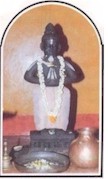 Sri
Raval Naickan, a young business man and an ardent devotee of Lord Narasimha, came and
settled in Thuravoor near the Vadakkanappan temple. He visited the
temple every day without fail and attended the Deeparadhana from outside. In those days
GSBs were not allowed inside other Hindu temples. He was not liked by the poojaris of the
temple. One day the poojaris closed the temple early and even refused to give him any
prasadam. With breaking heart, he prayed to Lord from outside the temple. He heard
somebody asking him to go westward. He followed a light moving towards West. Sri
Raval Naickan, a young business man and an ardent devotee of Lord Narasimha, came and
settled in Thuravoor near the Vadakkanappan temple. He visited the
temple every day without fail and attended the Deeparadhana from outside. In those days
GSBs were not allowed inside other Hindu temples. He was not liked by the poojaris of the
temple. One day the poojaris closed the temple early and even refused to give him any
prasadam. With breaking heart, he prayed to Lord from outside the temple. He heard
somebody asking him to go westward. He followed a light moving towards West.
When he reached the location of the present
temple, the light disappeared and he felt somebody telling him to have a prathista there.
At that time two sculptors appeared there and Raval Naickan requested them to make a
Narasimha Vigraha for him. They made a silpalaya (an enclosure) and entered therein to
make the vigraha. Raval Naickan waited for sometime and later impatiently peeped into the
silpalaya since he could not hear any sound from inside. He found two Vigrahas there (one
Ugra Narasimha and one Lekshmi Narasimha) and the sculptors missing. However, the Ugra
Narasimha Vigraha was not fully finished with tip of a finger of one foot
incomplete. Raval Naickan believed that the sculptors were divine (Vadakkanappan and
Thekkanappan) and constructed a small temple there for the Narasimha Moorthy. He also
constructed his house near to the temple. In the begining, the affairs of the temple were
managed by Sri Raval Naickan himself and later when he became aged, handed over the
governance to Cochin Tirumala Devaswom in 1704 AD. Thuravoor area was then part of the
Cochin state. A new temple and agrasalas were constructed during this period. The
extensive land owned by the temple and financial assistance for construction of the temple
were donated by the Maharaja of Cochin. The original pratishta was facing West. A peepal
tree and the althara is seen even today at the west gate of the temple. It was
later believed that the declining agricultural yield in the vast paddy fields between the
temple and the sea (towards west of the temple) and heavy sea erosion was due to the drishti of Narasimha murthy and hence the new temple and prathista
was made facing East. The temple was financially very sound and had vast landed properties
spread in Thuravoor and Varapuzha.
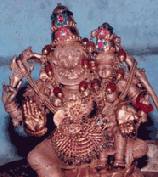 During the persecution of Konkanis in Cochin state, many GSBs shifted to
Alleppey which was in Travancore state. The Ugra Narasimha vigraha from Thuravoor also
was shifted to Alleppey Old Tirumala temple (along with the Venkatachalapathy idol
from Cochin) in 1792 AD and eventually was installed in Alleppey Anantha Narayana Puram
temple in 1852 AD. By this time Thuravoor became a part of Travancore State. After
the death of Raja Sakthan Thampuran, many went back to Cochin. The new Raja of Cochin
realised the importance of the Cochin Venkatachalapathy idol and demanded it back but in
vain. The Venkatachalapathy idol was clandestinely taken back to Cochin on the midnight of
7th Feb 1853. The members in Thuravoor severed the ties with Cochin temple. This resulted
in infights between community members in Cochin and Travancore states for ownership
and control of the Thuravoor Temple and its vast properties. The Cochin members filed a
suit in Quilon Court in 1883 AD for this purpose. For some time, the temple was under a Receiver
appointed by the Court. Later in 1895 AD, the Court decided that the Alleppey and
Thuravoor temple belongs to the entire Community members (in the eight villages or Ashta
gramas) of Travancore state. The Ashtagramas are Alleppey, Thuravoor, Shertallai,
Purakkad, Kayamkulam, Quilon, Kottayam and Parur. Accordingly the Alleppey
Anathanarayanapuram Thuravoor Tirumala Devaswom (AATTD) was formed and managed by
elected members from the Ashtagramas. This Devaswom was very rich and initiated many
educational projects. The Devaswom runs a High school and Teachers Training Institute near
the temple at Thuravoor and a High School at Alleppey. During the persecution of Konkanis in Cochin state, many GSBs shifted to
Alleppey which was in Travancore state. The Ugra Narasimha vigraha from Thuravoor also
was shifted to Alleppey Old Tirumala temple (along with the Venkatachalapathy idol
from Cochin) in 1792 AD and eventually was installed in Alleppey Anantha Narayana Puram
temple in 1852 AD. By this time Thuravoor became a part of Travancore State. After
the death of Raja Sakthan Thampuran, many went back to Cochin. The new Raja of Cochin
realised the importance of the Cochin Venkatachalapathy idol and demanded it back but in
vain. The Venkatachalapathy idol was clandestinely taken back to Cochin on the midnight of
7th Feb 1853. The members in Thuravoor severed the ties with Cochin temple. This resulted
in infights between community members in Cochin and Travancore states for ownership
and control of the Thuravoor Temple and its vast properties. The Cochin members filed a
suit in Quilon Court in 1883 AD for this purpose. For some time, the temple was under a Receiver
appointed by the Court. Later in 1895 AD, the Court decided that the Alleppey and
Thuravoor temple belongs to the entire Community members (in the eight villages or Ashta
gramas) of Travancore state. The Ashtagramas are Alleppey, Thuravoor, Shertallai,
Purakkad, Kayamkulam, Quilon, Kottayam and Parur. Accordingly the Alleppey
Anathanarayanapuram Thuravoor Tirumala Devaswom (AATTD) was formed and managed by
elected members from the Ashtagramas. This Devaswom was very rich and initiated many
educational projects. The Devaswom runs a High school and Teachers Training Institute near
the temple at Thuravoor and a High School at Alleppey.
The introduction of
Kerala Land Reforms Act in 1963 relating to the fixation of ceiling on land
holdings, changed the fate of Devaswom and AATTD lost most of its land holdings making its
financial position weak.
A gold covered Flag mast was erected in 1949 AD.
Till late sixties, during the annual festival, there was free Sadya (meal) in the temple
for all community members on all the eight days with rice from paddy fields owned by
the temple. However, at present it is limited only to one day and that too by sponsorship.
The temple owned a Gosala located next to the
Elephant cottage until the late sixties and also had an elephant. The elephant of the
temple was treated as a pet of the whole community. The most famous of the elephants was Gajendran which lived till 1970 AD. The elephant cottage
is now non-existent and a Library and Reading room is constructed at this location. At
present, the temple maintains a small Gosala located next to the Reading room on the south
east side of the temple.
Vahanas and the Arattu
festival
The Lord has a number of Vahanas - Garuda,
Hanuman, Aswa, Chandra, Iravatha, Hamsa and Sesha vahanas and a silver palanquin. The Aswa
Vahana is the biggest and the most popular. click
here to view the vahanas.

Arattukulam & Mandapam |
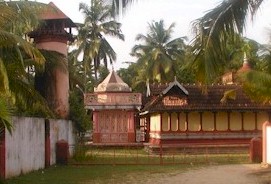
Pallivetta mandapam in the middle, Bhagavathy temple at right
and the outer wall of Arattukulam on the left.
|
On the fifth day of
the annual festival, Lord is taken out in the silver palanquin along the southern street
to the nearby Vigneswara temple and returns after Pooja and Uoonjal seva (swing). On the
sixth day Lord is taken out towards north to circumvent the Arthikulangara Bhagavathy
temple. On the seventh day Lord is taken out ceremoniously in the Aswa Vahana for Pallivetta
to the mandapam at the back side of the Bhagavathy temple.This procession is the most
attractive part of the festival. On eighth day, at night Lord is taken out in the silver
palanquin to the Arattu kulam near the Bhagavathy temple for Arattu. He is taken to the
Arattu manadapam at the center of the Arattu kulam on boat.
After pooja and Snanam (bath), He
returns to the temple early next morning.
Temple
details & Photo gallery
This temple is one of the most perfectly built
temples of GSBs in Kerala.
Thuravoor temple location map
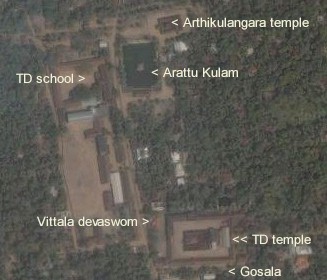
|
TD
temple layout 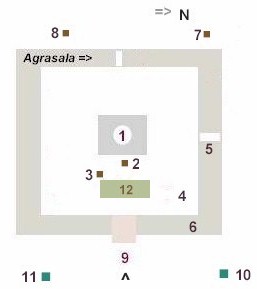 |
1. Srikovil
2. Flagmast 3. Hanuman kovil 4. Well 5.
Swamijis rest room (1st floor) 6. Kitchen 7. Vittala
sub-temple
8. Raval Naikan shrine 9. Main entrance 10. Temple
pond 11. Elephant cottage (Now locates Library and Reading
room)
12. Anapandal 13. Althara |
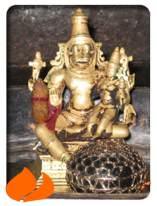
Lord Lakshmi Narasimha
|
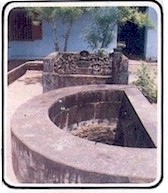
Yakshi Naga Peedam and Well
|
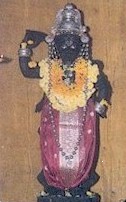
Hanuman Devar
|
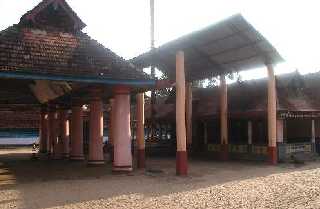
Inside view of Anapandal and Nalambalam
|
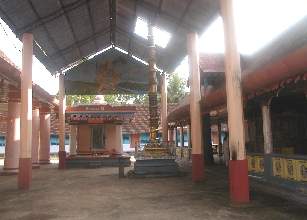
Hanuman Pratishta (Vrindavan)
|

A side view of Nalambalam
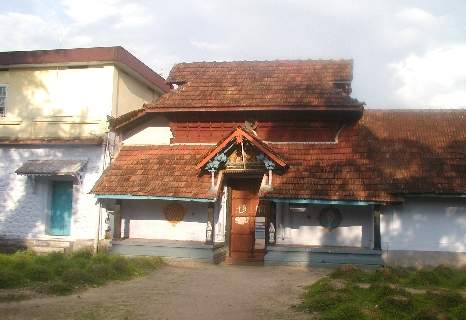
The west gopuram at backside
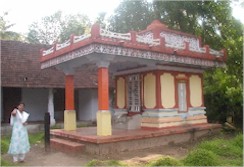
The Raval Naicken shrine on the left side of Althara
|
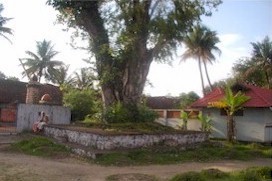
The Althara outside west gopuram (Vittala devasthan on the right)
|
Sree
Vittala Devasthan
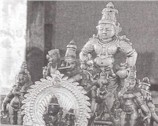 The poojaris of this main temple were from
Cochin who belonged to the Athri gotra. They settled near the temple and their kuladevata
Vittala was initially kept in one corner of the Srikovil. Later when poojaris from other
gotra also were appointed as poojaris, Sree Vittala was shited to the Nalambalam. In
1960s, the members of the Athri gotra, with permission and help of the Devaswom,
constructed a small temple outside the main temple near the Althara and installed Sree
Vittala there along with Venkatachalapathy, Bhoomi devi, Lakshmi devi, Sree Gopalakrishna
with Satyabhama and Rukmini, and Salagramas. In 2004, some changes were observed on a
Salagrama and a Devaprasnam was conducted. Subsequently, the temple was renovated and a
Bhagana mandapam constructed as seen in picture below. Half of the income in this temple
goes to the main temple as Kuladevar kanikam. The poojaris of this main temple were from
Cochin who belonged to the Athri gotra. They settled near the temple and their kuladevata
Vittala was initially kept in one corner of the Srikovil. Later when poojaris from other
gotra also were appointed as poojaris, Sree Vittala was shited to the Nalambalam. In
1960s, the members of the Athri gotra, with permission and help of the Devaswom,
constructed a small temple outside the main temple near the Althara and installed Sree
Vittala there along with Venkatachalapathy, Bhoomi devi, Lakshmi devi, Sree Gopalakrishna
with Satyabhama and Rukmini, and Salagramas. In 2004, some changes were observed on a
Salagrama and a Devaprasnam was conducted. Subsequently, the temple was renovated and a
Bhagana mandapam constructed as seen in picture below. Half of the income in this temple
goes to the main temple as Kuladevar kanikam.
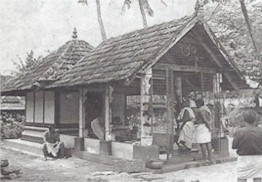
The Vittala devasthan - An old pic
|
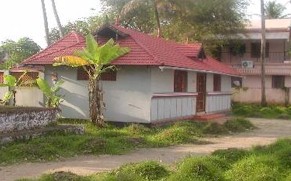
Vittala devasthan - Recently renovated
|
Arthikulangara
Bhagavathy temple
This temple under AATTD is near the TD temple and
next to the Arattukulam. This temple orginally belonged to the Kanjirampally Karta family
who handed over it to the local Kunbi community. The Kunbis
later on handed over the temple to Tirumala Devaswom. Authentic dates in this regard is
unavailable. The pratishta in the temple is Yantra form.
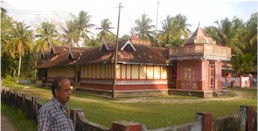
Bhagavathy temple - backside view
(The Pallivetta peedam seen in pic & Arattu kulam is on the right side not seen in
pic)
|

Bhagavathy temple - front view |
Sree Vigneswara temple
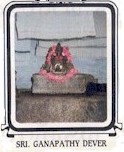 This temple under AATTD is about 1.5 km to the south of the TD temple in
opposite direction to the Arattukulam. On the fifth day of the annual festival, Lord is
taken out in the silver palanquin along the southern street to this temple and returns
after Pooja and Uoonjal seva (swing). This temple under AATTD is about 1.5 km to the south of the TD temple in
opposite direction to the Arattukulam. On the fifth day of the annual festival, Lord is
taken out in the silver palanquin along the southern street to this temple and returns
after Pooja and Uoonjal seva (swing).
Also in
Thuravoor
The
Vadakkanappan Temple
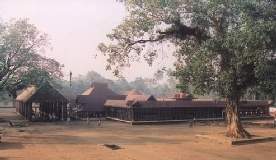 Thuravoor
Mahakshethram, locally called Vadakkanappan temple, located by the side of NH-47, is the
abode of Ugra Narasimhamurthy and Sudarsanamurthy. This location is called Nadakkal.
The entire temple complex can be seen from the NH47 road overlooking the temple pond.
Twin-Sreekovils in a single Nalambalam, two gold-plated flagmasts and a majestically tall
Anapandhal (Elephant Rostrum - the largest in Kerala) make it a distinctive
temple. Of the two srikovils here, it is believed that the one dedicated to
Sudarsanamoorthy was the first to come into existence. Though there is no record of its
origin, the temple is estimated to be over 1300 years old. As for the
Narasimhamoorthy temple, records show that it came into being sometime in the 7th century
AD, during the reign of Chera king Keralendran. Thuravoor
Mahakshethram, locally called Vadakkanappan temple, located by the side of NH-47, is the
abode of Ugra Narasimhamurthy and Sudarsanamurthy. This location is called Nadakkal.
The entire temple complex can be seen from the NH47 road overlooking the temple pond.
Twin-Sreekovils in a single Nalambalam, two gold-plated flagmasts and a majestically tall
Anapandhal (Elephant Rostrum - the largest in Kerala) make it a distinctive
temple. Of the two srikovils here, it is believed that the one dedicated to
Sudarsanamoorthy was the first to come into existence. Though there is no record of its
origin, the temple is estimated to be over 1300 years old. As for the
Narasimhamoorthy temple, records show that it came into being sometime in the 7th century
AD, during the reign of Chera king Keralendran.
 The idol of
Sudarsanamoorthy features four arms, each carrying a different object: a conch shell, a
chakra (discus), a gadha (mace) and a lotus bloom. The gold-plated flagmast on the eastern
side of the Sudarsanamoorthy temple is taller than its counterpart for the Narasima
temple. The idol of Sree Narasimhamoorthy is said to have originated in the holy city of
Kashi. Unlike in most other Narasimha temples, Sree Narasimhamurthy here is in standing
posture. The Narasimhamurthy on the Northern side is called Vadakkanappan
and Sudarsanamoorthy on the south side is called Thekkanappan. The idol of
Sudarsanamoorthy features four arms, each carrying a different object: a conch shell, a
chakra (discus), a gadha (mace) and a lotus bloom. The gold-plated flagmast on the eastern
side of the Sudarsanamoorthy temple is taller than its counterpart for the Narasima
temple. The idol of Sree Narasimhamoorthy is said to have originated in the holy city of
Kashi. Unlike in most other Narasimha temples, Sree Narasimhamurthy here is in standing
posture. The Narasimhamurthy on the Northern side is called Vadakkanappan
and Sudarsanamoorthy on the south side is called Thekkanappan.
 During pilgrimage to Varanasi, a
Namboothiri priest from Angamally had a supernatural vision. He saw a brilliant beam
of light descending towards the earth and travelling in a southwest direction. The priest
followed the beam closely. At a pre-ordained point in a village called
‘Poothanilam’ in central Kerala, the light hit the earth and disappeared into
the ground. The priest dug the earth at this spot and saw an extraordinarily
beautiful idol of Mahavishnu in Anjanakallu (a rare kind of black stone) buried
underneath. This Vishnu idol was later to become famous as Sree Narasimhamoorthy. The
priest enshrined the idol in a Sreekovil of its own near the sanctum of Sudarsanamoorthy.
It is said that the idol occupies a site, which was originally the abode of Goddess
Bhagavathy. The Bhagavathy idol was relocated within the temple premises at a place a
little towards the west, as per Hindu ideology. During pilgrimage to Varanasi, a
Namboothiri priest from Angamally had a supernatural vision. He saw a brilliant beam
of light descending towards the earth and travelling in a southwest direction. The priest
followed the beam closely. At a pre-ordained point in a village called
‘Poothanilam’ in central Kerala, the light hit the earth and disappeared into
the ground. The priest dug the earth at this spot and saw an extraordinarily
beautiful idol of Mahavishnu in Anjanakallu (a rare kind of black stone) buried
underneath. This Vishnu idol was later to become famous as Sree Narasimhamoorthy. The
priest enshrined the idol in a Sreekovil of its own near the sanctum of Sudarsanamoorthy.
It is said that the idol occupies a site, which was originally the abode of Goddess
Bhagavathy. The Bhagavathy idol was relocated within the temple premises at a place a
little towards the west, as per Hindu ideology.
|
